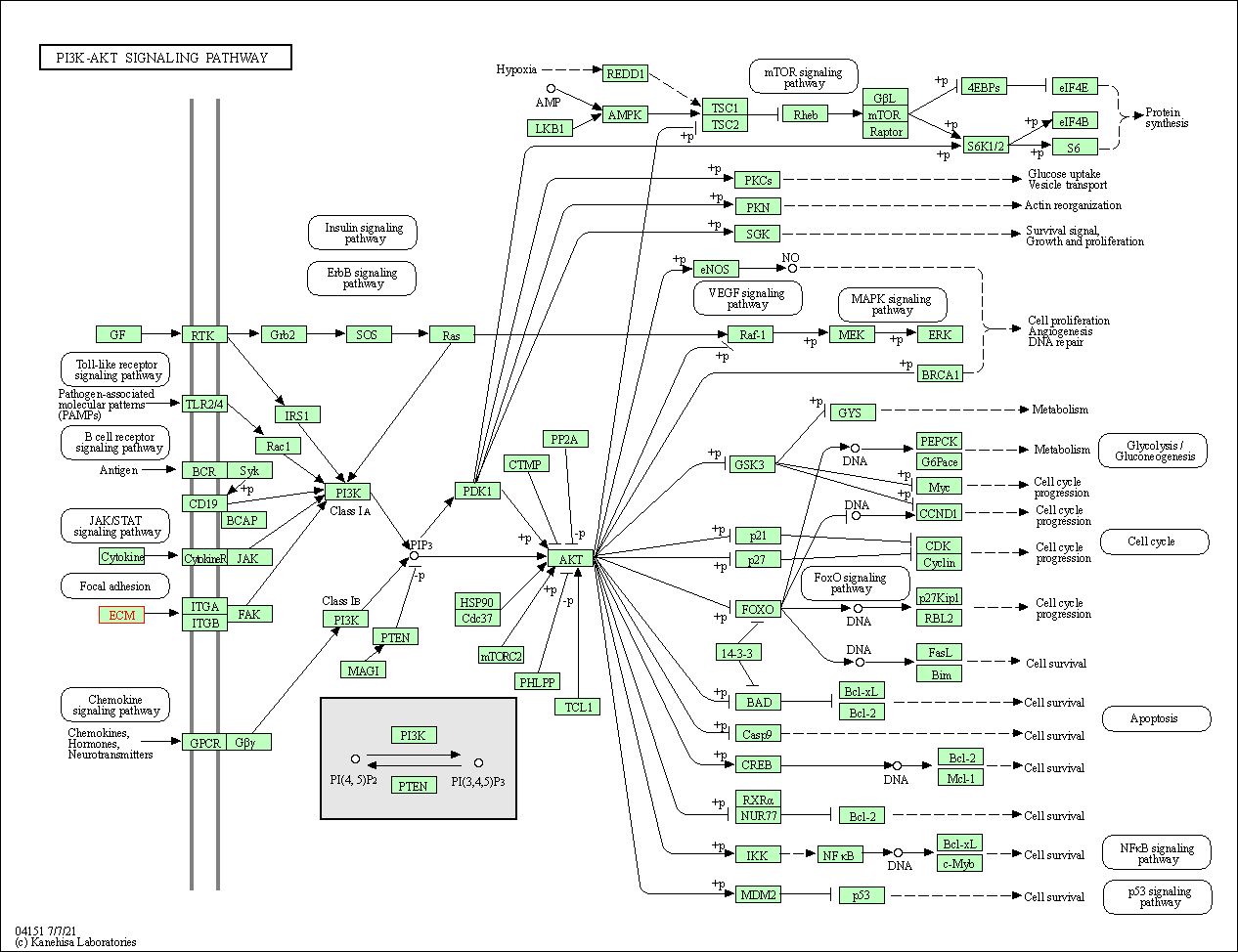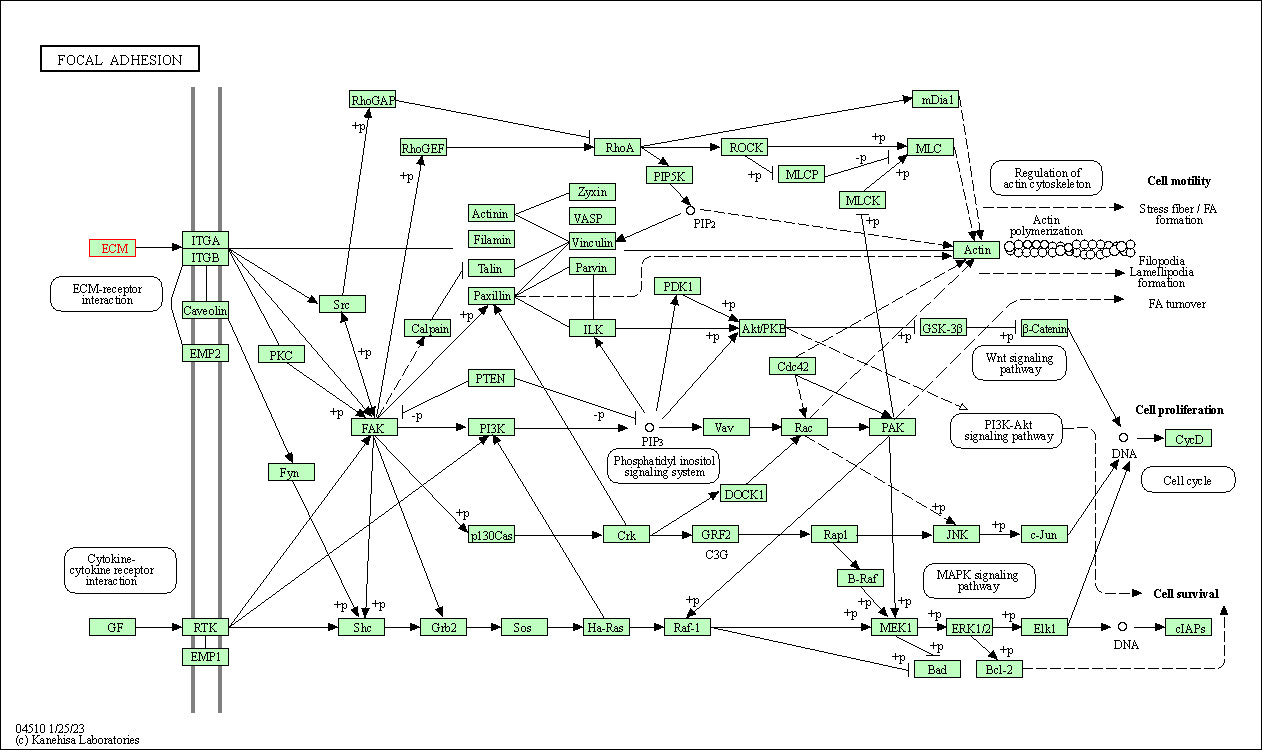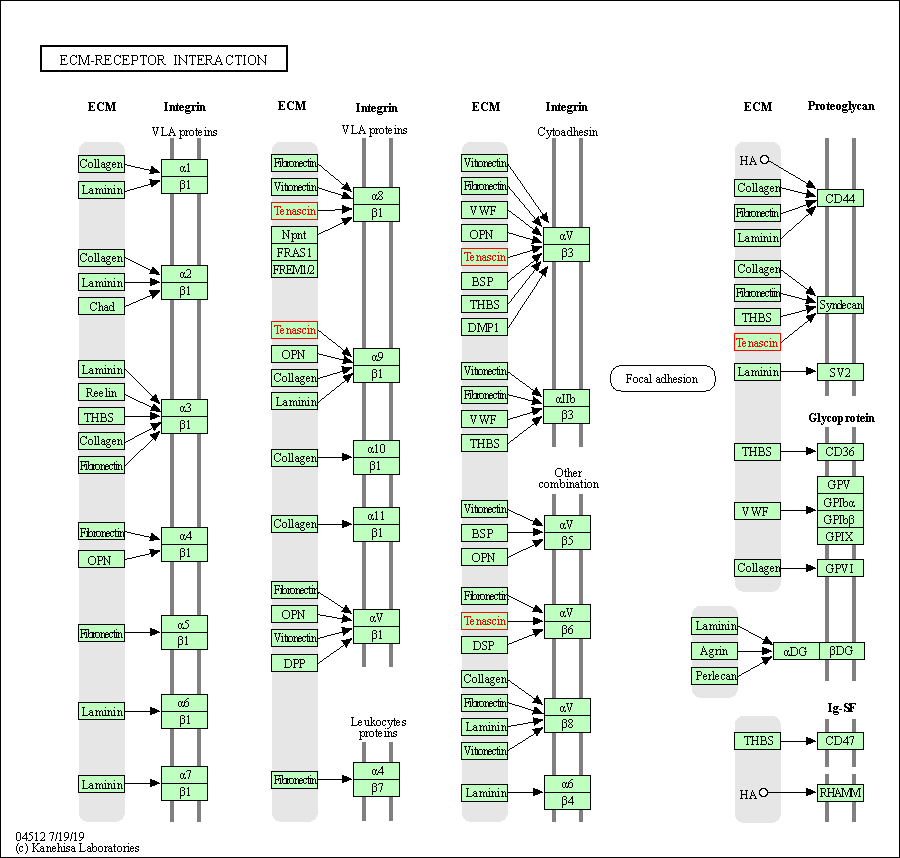Target Information
| Target General Information | Top | |||||
|---|---|---|---|---|---|---|
| Target ID |
T86254
(Former ID: TTDR00683)
|
|||||
| Target Name |
Tenascin (TNC)
|
|||||
| Synonyms |
Tenascin-C; TN-C; TN; Neuronectin; Myotendinous antigen; Miotendinous antigen; JI; Hexabrachion; HXB; Glioma-associated-extracellular matrix antigen; GP 150-225; GMEM; Cytotactin
Click to Show/Hide
|
|||||
| Gene Name |
TNC
|
|||||
| Target Type |
Clinical trial target
|
[1] | ||||
| Disease | [+] 3 Target-related Diseases | + | ||||
| 1 | Solid tumour/cancer [ICD-11: 2A00-2F9Z] | |||||
| 2 | Malignant haematopoietic neoplasm [ICD-11: 2B33] | |||||
| 3 | Brain cancer [ICD-11: 2A00] | |||||
| Function |
Promotes neurite outgrowth from cortical neurons grown on a monolayer of astrocytes. Ligand for integrins alpha-8/beta-1, alpha-9/beta-1, alpha-V/beta-3 and alpha-V/beta-6. In tumors, stimulates angiogenesis by elongation, migration and sprouting of endothelial cells. Extracellular matrix protein implicated in guidance of migrating neurons as well as axons during development, synaptic plasticity as well as neuronal regeneration.
Click to Show/Hide
|
|||||
| UniProt ID | ||||||
| Sequence |
MGAMTQLLAGVFLAFLALATEGGVLKKVIRHKRQSGVNATLPEENQPVVFNHVYNIKLPV
GSQCSVDLESASGEKDLAPPSEPSESFQEHTVDGENQIVFTHRINIPRRACGCAAAPDVK ELLSRLEELENLVSSLREQCTAGAGCCLQPATGRLDTRPFCSGRGNFSTEGCGCVCEPGW KGPNCSEPECPGNCHLRGRCIDGQCICDDGFTGEDCSQLACPSDCNDQGKCVNGVCICFE GYAGADCSREICPVPCSEEHGTCVDGLCVCHDGFAGDDCNKPLCLNNCYNRGRCVENECV CDEGFTGEDCSELICPNDCFDRGRCINGTCYCEEGFTGEDCGKPTCPHACHTQGRCEEGQ CVCDEGFAGVDCSEKRCPADCHNRGRCVDGRCECDDGFTGADCGELKCPNGCSGHGRCVN GQCVCDEGYTGEDCSQLRCPNDCHSRGRCVEGKCVCEQGFKGYDCSDMSCPNDCHQHGRC VNGMCVCDDGYTGEDCRDRQCPRDCSNRGLCVDGQCVCEDGFTGPDCAELSCPNDCHGQG RCVNGQCVCHEGFMGKDCKEQRCPSDCHGQGRCVDGQCICHEGFTGLDCGQHSCPSDCNN LGQCVSGRCICNEGYSGEDCSEVSPPKDLVVTEVTEETVNLAWDNEMRVTEYLVVYTPTH EGGLEMQFRVPGDQTSTIIQELEPGVEYFIRVFAILENKKSIPVSARVATYLPAPEGLKF KSIKETSVEVEWDPLDIAFETWEIIFRNMNKEDEGEITKSLRRPETSYRQTGLAPGQEYE ISLHIVKNNTRGPGLKRVTTTRLDAPSQIEVKDVTDTTALITWFKPLAEIDGIELTYGIK DVPGDRTTIDLTEDENQYSIGNLKPDTEYEVSLISRRGDMSSNPAKETFTTGLDAPRNLR RVSQTDNSITLEWRNGKAAIDSYRIKYAPISGGDHAEVDVPKSQQATTKTTLTGLRPGTE YGIGVSAVKEDKESNPATINAATELDTPKDLQVSETAETSLTLLWKTPLAKFDRYRLNYS LPTGQWVGVQLPRNTTSYVLRGLEPGQEYNVLLTAEKGRHKSKPARVKASTEQAPELENL TVTEVGWDGLRLNWTAADQAYEHFIIQVQEANKVEAARNLTVPGSLRAVDIPGLKAATPY TVSIYGVIQGYRTPVLSAEASTGETPNLGEVVVAEVGWDALKLNWTAPEGAYEYFFIQVQ EADTVEAAQNLTVPGGLRSTDLPGLKAATHYTITIRGVTQDFSTTPLSVEVLTEEVPDMG NLTVTEVSWDALRLNWTTPDGTYDQFTIQVQEADQVEEAHNLTVPGSLRSMEIPGLRAGT PYTVTLHGEVRGHSTRPLAVEVVTEDLPQLGDLAVSEVGWDGLRLNWTAADNAYEHFVIQ VQEVNKVEAAQNLTLPGSLRAVDIPGLEAATPYRVSIYGVIRGYRTPVLSAEASTAKEPE IGNLNVSDITPESFNLSWMATDGIFETFTIEIIDSNRLLETVEYNISGAERTAHISGLPP STDFIVYLSGLAPSIRTKTISATATTEALPLLENLTISDINPYGFTVSWMASENAFDSFL VTVVDSGKLLDPQEFTLSGTQRKLELRGLITGIGYEVMVSGFTQGHQTKPLRAEIVTEAE PEVDNLLVSDATPDGFRLSWTADEGVFDNFVLKIRDTKKQSEPLEITLLAPERTRDITGL REATEYEIELYGISKGRRSQTVSAIATTAMGSPKEVIFSDITENSATVSWRAPTAQVESF RITYVPITGGTPSMVTVDGTKTQTRLVKLIPGVEYLVSIIAMKGFEESEPVSGSFTTALD GPSGLVTANITDSEALARWQPAIATVDSYVISYTGEKVPEITRTVSGNTVEYALTDLEPA TEYTLRIFAEKGPQKSSTITAKFTTDLDSPRDLTATEVQSETALLTWRPPRASVTGYLLV YESVDGTVKEVIVGPDTTSYSLADLSPSTHYTAKIQALNGPLRSNMIQTIFTTIGLLYPF PKDCSQAMLNGDTTSGLYTIYLNGDKAEALEVFCDMTSDGGGWIVFLRRKNGRENFYQNW KAYAAGFGDRREEFWLGLDNLNKITAQGQYELRVDLRDHGETAFAVYDKFSVGDAKTRYK LKVEGYSGTAGDSMAYHNGRSFSTFDKDTDSAITNCALSYKGAFWYRNCHRVNLMGRYGD NNHSQGVNWFHWKGHEHSIQFAEMKLRPSNFRNLEGRRKRA Click to Show/Hide
|
|||||
| 3D Structure | Click to Show 3D Structure of This Target | AlphaFold | ||||
| HIT2.0 ID | T07QLG | |||||
| Drugs and Modes of Action | Top | |||||
|---|---|---|---|---|---|---|
| Clinical Trial Drug(s) | [+] 3 Clinical Trial Drugs | + | ||||
| 1 | F-16-IL-2 fusion protein | Drug Info | Phase 2 | Solid tumour/cancer | [2] | |
| 2 | F-16-131I | Drug Info | Phase 1/2 | Haematological malignancy | [3] | |
| 3 | 8H9 | Drug Info | Phase 1 | Solid tumour/cancer | [4] | |
| Discontinued Drug(s) | [+] 1 Discontinued Drugs | + | ||||
| 1 | 131I-81C6 | Drug Info | Terminated | Brain cancer | [5] | |
| Mode of Action | [+] 1 Modes of Action | + | ||||
| Modulator | [+] 1 Modulator drugs | + | ||||
| 1 | F-16-IL-2 fusion protein | Drug Info | [1] | |||
| Cell-based Target Expression Variations | Top | |||||
|---|---|---|---|---|---|---|
| Cell-based Target Expression Variations | ||||||
| Drug Binding Sites of Target | Top | |||||
|---|---|---|---|---|---|---|
| Ligand Name: 1-(3-Methyl-1,2,4-thiadiazol-5-yl)-1,4-diazepane | Ligand Info | |||||
| Structure Description | PanDDA analysis group deposition -- Crystal Structure of FIBRINOGEN-LIKE GLOBE DOMAIN OF HUMAN TENASCIN-C in complex with Z1578665941 | PDB:5R61 | ||||
| Method | X-ray diffraction | Resolution | 1.38 Å | Mutation | No | [9] |
| PDB Sequence |
SMPFPKDCSQ
1986 AMLNGDTTSG1996 LYTIYLNGDK2006 AQALEVFCDM2016 TSDGGGWIVF2026 LRRKNGRENF 2036 YQNWKAYAAG2046 FGDRREEFWL2056 GLDNLNKITA2066 QGQYELRVDL2076 RDHGETAFAV 2086 YDKFSVGDAK2096 TRYKLKVEGY2106 SGTAGDSMAY2116 HNGRSFSTFD2126 KNCALSYKGA 2143 FWYRNCHRVN2153 LMGRYGDNNH2163 SQGVNWFHWK2173 GHEHSIQFAE2183 MKLRPSNFRN 2193 L
|
|||||
|
|
||||||
| Ligand Name: 4-(4-Methylpiperazin-1-yl)benzonitrile | Ligand Info | |||||
| Structure Description | PanDDA analysis group deposition -- Crystal Structure of FIBRINOGEN-LIKE GLOBE DOMAIN OF HUMAN TENASCIN-C in complex with Z2856434840 | PDB:5R62 | ||||
| Method | X-ray diffraction | Resolution | 1.40 Å | Mutation | No | [10] |
| PDB Sequence |
SMPFPKDCSQ
1986 AMLNGDTTSG1996 LYTIYLNGDK2006 AQALEVFCDM2016 TSDGGGWIVF2026 LRRKNGRENF 2036 YQNWKAYAAG2046 FGDRREEFWL2056 GLDNLNKITA2066 QGQYELRVDL2076 RDHGETAFAV 2086 YDKFSVGDAK2096 TRYKLKVEGY2106 SGTAGDSMAY2116 HNGRSFSTFD2126 KNCALSYKGA 2143 FWYRNCHRVN2153 LMGRYGDNNH2163 SQGVNWFHWK2173 GHEHSIQFAE2183 MKLRPSNFRN 2193 L
|
|||||
|
|
||||||
| Click to View More Binding Site Information of This Target with Different Ligands | ||||||
| Different Human System Profiles of Target | Top |
|---|---|
|
Human Similarity Proteins
of target is determined by comparing the sequence similarity of all human proteins with the target based on BLAST. The similarity proteins for a target are defined as the proteins with E-value < 0.005 and outside the protein families of the target.
A target that has fewer human similarity proteins outside its family is commonly regarded to possess a greater capacity to avoid undesired interactions and thus increase the possibility of finding successful drugs
(Brief Bioinform, 21: 649-662, 2020).
Human Tissue Distribution
of target is determined from a proteomics study that quantified more than 12,000 genes across 32 normal human tissues. Tissue Specificity (TS) score was used to define the enrichment of target across tissues.
The distribution of targets among different tissues or organs need to be taken into consideration when assessing the target druggability, as it is generally accepted that the wider the target distribution, the greater the concern over potential adverse effects
(Nat Rev Drug Discov, 20: 64-81, 2021).
Human Pathway Affiliation
of target is determined by the life-essential pathways provided on KEGG database. The target-affiliated pathways were defined based on the following two criteria (a) the pathways of the studied target should be life-essential for both healthy individuals and patients, and (b) the studied target should occupy an upstream position in the pathways and therefore had the ability to regulate biological function.
Targets involved in a fewer pathways have greater likelihood to be successfully developed, while those associated with more human pathways increase the chance of undesirable interferences with other human processes
(Pharmacol Rev, 58: 259-279, 2006).
Human Similarity Proteins
Human Tissue Distribution
Human Pathway Affiliation
|
|
|
Note:
If a protein has TS (tissue specficity) scores at least in one tissue >= 2.5, this protein is called tissue-enriched (including tissue-enriched-but-not-specific and tissue-specific). In the plots, the vertical lines are at thresholds 2.5 and 4.
|
| KEGG Pathway | Pathway ID | Affiliated Target | Pathway Map |
|---|---|---|---|
| PI3K-Akt signaling pathway | hsa04151 | Affiliated Target |

|
| Class: Environmental Information Processing => Signal transduction | Pathway Hierarchy | ||
| Focal adhesion | hsa04510 | Affiliated Target |

|
| Class: Cellular Processes => Cellular community - eukaryotes | Pathway Hierarchy | ||
| ECM-receptor interaction | hsa04512 | Affiliated Target |

|
| Class: Environmental Information Processing => Signaling molecules and interaction | Pathway Hierarchy | ||
| Target Regulators | Top | |||||
|---|---|---|---|---|---|---|
| Target-regulating microRNAs | ||||||
| Target Profiles in Patients | Top | |||||
|---|---|---|---|---|---|---|
| Target Expression Profile (TEP) | ||||||
| Target Affiliated Biological Pathways | Top | |||||
|---|---|---|---|---|---|---|
| KEGG Pathway | [+] 4 KEGG Pathways | + | ||||
| 1 | PI3K-Akt signaling pathway | |||||
| 2 | Focal adhesion | |||||
| 3 | ECM-receptor interaction | |||||
| 4 | MicroRNAs in cancer | |||||
| NetPath Pathway | [+] 2 NetPath Pathways | + | ||||
| 1 | IL4 Signaling Pathway | |||||
| 2 | TGF_beta_Receptor Signaling Pathway | |||||
| PID Pathway | [+] 4 PID Pathways | + | ||||
| 1 | Beta1 integrin cell surface interactions | |||||
| 2 | Beta3 integrin cell surface interactions | |||||
| 3 | Alpha9 beta1 integrin signaling events | |||||
| 4 | Syndecan-4-mediated signaling events | |||||
| Reactome | [+] 3 Reactome Pathways | + | ||||
| 1 | Integrin cell surface interactions | |||||
| 2 | Syndecan interactions | |||||
| 3 | ECM proteoglycans | |||||
| WikiPathways | [+] 5 WikiPathways | + | ||||
| 1 | TGF beta Signaling Pathway | |||||
| 2 | Focal Adhesion | |||||
| 3 | Syndecan interactions | |||||
| 4 | Extracellular matrix organization | |||||
| 5 | Integrin cell surface interactions | |||||
| References | Top | |||||
|---|---|---|---|---|---|---|
| REF 1 | National Cancer Institute Drug Dictionary (drug id 674718). | |||||
| REF 2 | Trusted, scientifically sound profiles of drug programs, clinical trials, safety reports, and company deals, written by scientists. Springer. 2015. Adis Insight (drug id 800031837) | |||||
| REF 3 | Trusted, scientifically sound profiles of drug programs, clinical trials, safety reports, and company deals, written by scientists. Springer. 2015. Adis Insight (drug id 800031840) | |||||
| REF 4 | ClinicalTrials.gov (NCT01099644) Intraperitoneal Radioimmunotherapy With 131I-8H9 for Patients With Desmoplastic Small Round Cell Tumors and Other Solid Tumors Involving the Peritoneum. U.S. NationalInstitutes of Health. | |||||
| REF 5 | Human IgG2 constant region enhances in vivo stability of anti-tenascin antibody 81C6 compared with its murine parent. Clin Cancer Res. 1998 Oct;4(10):2495-502. | |||||
| REF 6 | Tumor-Associated Fibroblasts and their Matrix. Springer. Margareta M. Mueller,Norbert E. Fusenig, 2011. Page(775). | |||||
| REF 7 | In vitro and in vivo cytotoxic activities of recombinant immunotoxin 8H9(Fv)-PE38 against breast cancer, osteosarcoma, and neuroblastoma. Cancer Res. 2004 Feb 15;64(4):1419-24. | |||||
| REF 8 | A pilot study: 131I-Antitenascin monoclonal antibody 81c6 to deliver a 44-Gy resection cavity boost. Neuro Oncol. 2008 April; 10(2): 182-189. | |||||
| REF 9 | PanDDA analysis group deposition | |||||
| REF 10 | PanDDA analysis group deposition | |||||
If You Find Any Error in Data or Bug in Web Service, Please Kindly Report It to Dr. Zhou and Dr. Zhang.

